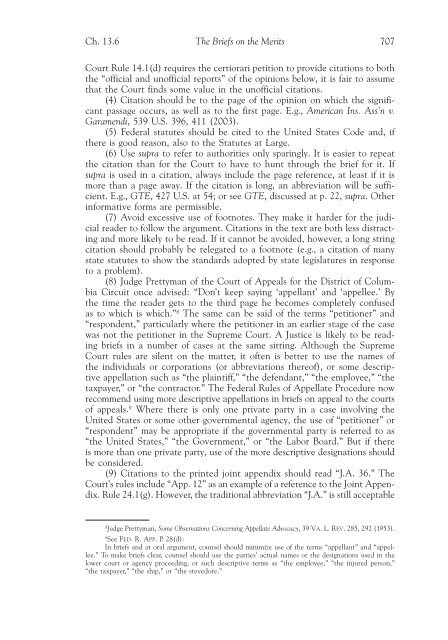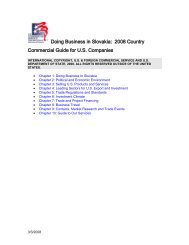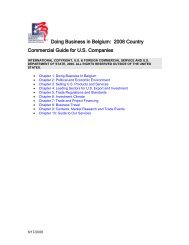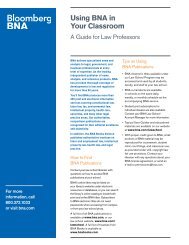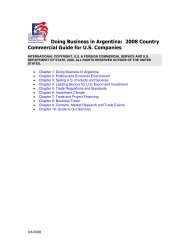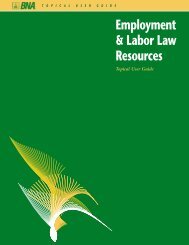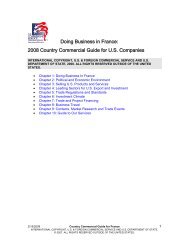You also want an ePaper? Increase the reach of your titles
YUMPU automatically turns print PDFs into web optimized ePapers that Google loves.
Ch. 13.6 <str<strong>on</strong>g>The</str<strong>on</strong>g> <str<strong>on</strong>g>Briefs</str<strong>on</strong>g> <strong>on</strong> <strong>the</strong> <strong>Merits</strong> 707<br />
Court Rule 14.1(d) requires <strong>the</strong> certiorari petiti<strong>on</strong> to provide citati<strong>on</strong>s to both<br />
<strong>the</strong> “official and unofficial reports” of <strong>the</strong> opini<strong>on</strong>s below, it is fair to assume<br />
that <strong>the</strong> Court finds some value in <strong>the</strong> unofficial citati<strong>on</strong>s.<br />
(4) Citati<strong>on</strong> should be to <strong>the</strong> page of <strong>the</strong> opini<strong>on</strong> <strong>on</strong> which <strong>the</strong> significant<br />
passage occurs, as well as to <strong>the</strong> first page. E.g., American Ins. Ass’n v.<br />
Garamendi, 539 U.S. 396, 411 (2003).<br />
(5) Federal statutes should be cited to <strong>the</strong> United States Code and, if<br />
<strong>the</strong>re is good reas<strong>on</strong>, also to <strong>the</strong> Statutes at Large.<br />
(6) Use supra to refer to authorities <strong>on</strong>ly sparingly. It is easier to repeat<br />
<strong>the</strong> citati<strong>on</strong> than for <strong>the</strong> Court to have to hunt through <strong>the</strong> brief for it. If<br />
supra is used in a citati<strong>on</strong>, always include <strong>the</strong> page reference, at least if it is<br />
more than a page away. If <strong>the</strong> citati<strong>on</strong> is l<strong>on</strong>g, an abbreviati<strong>on</strong> will be sufficient.<br />
E.g., GTE, 427 U.S. at 54; or see GTE, discussed at p. 22, supra. O<strong>the</strong>r<br />
informative forms are permissible.<br />
(7) Avoid excessive use of footnotes. <str<strong>on</strong>g>The</str<strong>on</strong>g>y make it harder for <strong>the</strong> judicial<br />
reader to follow <strong>the</strong> argument. Citati<strong>on</strong>s in <strong>the</strong> text are both less distracting<br />
and more likely to be read. If it cannot be avoided, however, a l<strong>on</strong>g string<br />
citati<strong>on</strong> should probably be relegated to a footnote (e.g., a citati<strong>on</strong> of many<br />
state statutes to show <strong>the</strong> standards adopted by state legislatures in resp<strong>on</strong>se<br />
to a problem).<br />
(8) Judge Prettyman of <strong>the</strong> Court of Appeals for <strong>the</strong> District of Columbia<br />
Circuit <strong>on</strong>ce advised: “D<strong>on</strong>’t keep saying ‘appellant’ and ‘appellee.’ By<br />
<strong>the</strong> time <strong>the</strong> reader gets to <strong>the</strong> third page he becomes completely c<strong>on</strong>fused<br />
as to which is which.” 8 <str<strong>on</strong>g>The</str<strong>on</strong>g> same can be said of <strong>the</strong> terms “petiti<strong>on</strong>er” and<br />
“resp<strong>on</strong>dent,” particularly where <strong>the</strong> petiti<strong>on</strong>er in an earlier stage of <strong>the</strong> case<br />
was not <strong>the</strong> petiti<strong>on</strong>er in <strong>the</strong> Supreme Court. A Justice is likely to be reading<br />
briefs in a number of cases at <strong>the</strong> same sitting. Although <strong>the</strong> Supreme<br />
Court rules are silent <strong>on</strong> <strong>the</strong> matter, it often is better to use <strong>the</strong> names of<br />
<strong>the</strong> individuals or corporati<strong>on</strong>s (or abbreviati<strong>on</strong>s <strong>the</strong>reof), or some descriptive<br />
appellati<strong>on</strong> such as “<strong>the</strong> plaintiff,” “<strong>the</strong> defendant,” “<strong>the</strong> employee,” “<strong>the</strong><br />
taxpayer,” or “<strong>the</strong> c<strong>on</strong>tractor.” <str<strong>on</strong>g>The</str<strong>on</strong>g> Federal Rules of Appellate Procedure now<br />
recommend using more descriptive appellati<strong>on</strong>s in briefs <strong>on</strong> appeal to <strong>the</strong> courts<br />
of appeals. 9 Where <strong>the</strong>re is <strong>on</strong>ly <strong>on</strong>e private party in a case involving <strong>the</strong><br />
United States or some o<strong>the</strong>r governmental agency, <strong>the</strong> use of “petiti<strong>on</strong>er” or<br />
“resp<strong>on</strong>dent” may be appropriate if <strong>the</strong> governmental party is referred to as<br />
“<strong>the</strong> United States,” “<strong>the</strong> Government,” or “<strong>the</strong> Labor Board.” But if <strong>the</strong>re<br />
is more than <strong>on</strong>e private party, use of <strong>the</strong> more descriptive designati<strong>on</strong>s should<br />
be c<strong>on</strong>sidered.<br />
(9) Citati<strong>on</strong>s to <strong>the</strong> printed joint appendix should read “J.A. 36.” <str<strong>on</strong>g>The</str<strong>on</strong>g><br />
Court’s rules include “App. 12” as an example of a reference to <strong>the</strong> Joint Appendix.<br />
Rule 24.1(g). However, <strong>the</strong> traditi<strong>on</strong>al abbreviati<strong>on</strong> “J.A.” is still acceptable<br />
8 Judge Prettyman, Some Observati<strong>on</strong>s C<strong>on</strong>cerning Appellate Advocacy, 39 VA. L. REV. 285, 292 (1953).<br />
9 See FED. R. APP. P. 28(d):<br />
In briefs and at oral argument, counsel should minimize use of <strong>the</strong> terms “appellant” and “appellee.”<br />
To make briefs clear, counsel should use <strong>the</strong> parties’ actual names or <strong>the</strong> designati<strong>on</strong>s used in <strong>the</strong><br />
lower court or agency proceeding, or such descriptive terms as “<strong>the</strong> employee,” “<strong>the</strong> injured pers<strong>on</strong>,”<br />
“<strong>the</strong> taxpayer,” “<strong>the</strong> ship,” or “<strong>the</strong> stevedore.”


